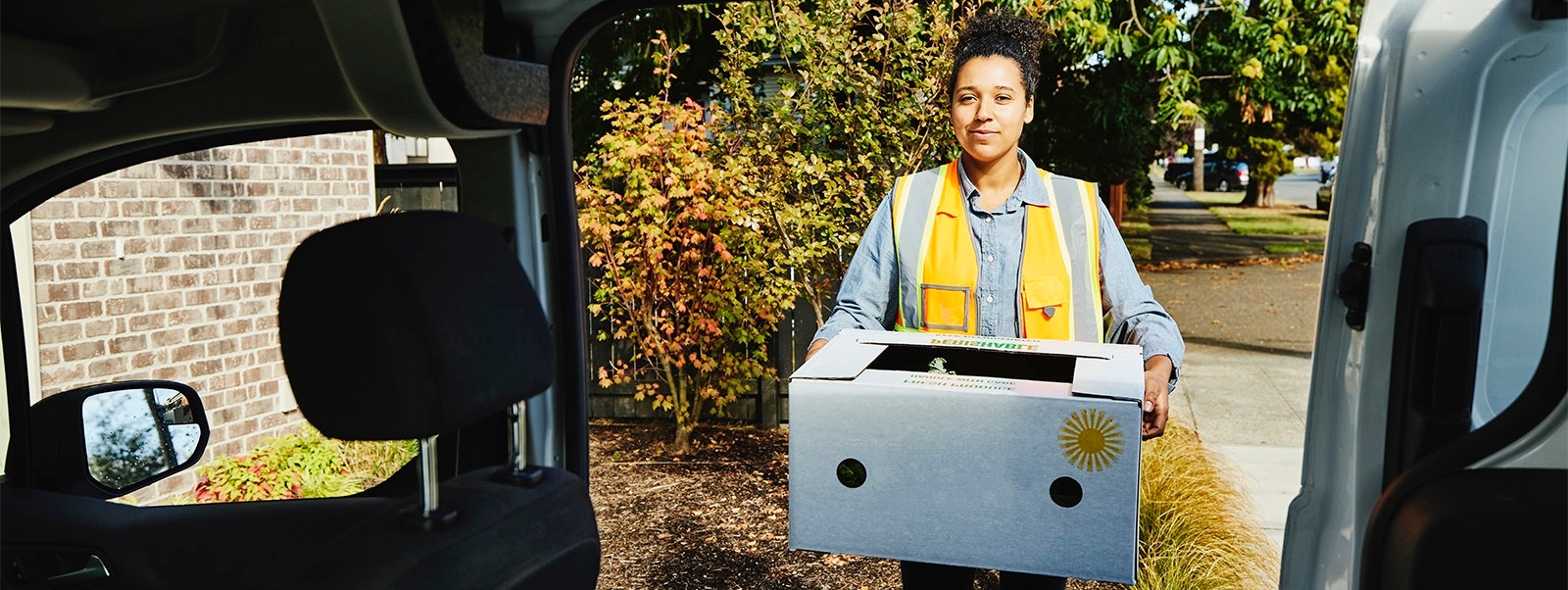And then COVID-19 happened.
Social distancing and stay-at-home orders have accelerated adoption of e-commerce from a steady march forward to a wild sprint to the finish line. Online demand will likely remain strong post-COVID-19, and retailers must adapt to the “new normal.” Defining a winning e-commerce strategy and building the required capabilities will undoubtedly be a challenge, but also a massive opportunity to increase scale and profitability potential. Three factors are crucial for such a strategy: develop a value proposition tailored to the online world, design the supply chain to meet the need for a more omni-channel world, and enable the transformation with the right technology, data, and people.
THE E-COMMERCE SURGE
E-commerce has been driving a massive change in retail due to changing demographics, increasing competition, and rising customer expectations. While e-commerce still only represented 16 percent of total global retail value in early 2020, it will continue to expand, and ultimately take the lion’s share of growth in the retail industry.
COVID-19’s impact on online shopping demand has only added to mounting pressures facing retailers. Lockdown mandates and self-isolation practices are dramatically changing consumption behavior. According to eMarketer, nearly half of consumers have shifted their spending towards online channels, across all categories ranging from grocery to apparel to electronics. Online orders are seeing two to three times year-on-year growth, with some retailers seeing increases of more than 20 times. Even online grocery, notable for its slow rate of customer adoption, has seen a massive increase in popularity over the past few months, driven by the desire for a contactless shopping experience.
While some retailers may be thinking this shift is a short-term storm to weather, our international research, conducted multiple times since the outbreak of COVID-19, shows otherwise. It indicates that up to a third of grocery customers who began online shopping in response to the virus have a desire to continue shopping online even after the pandemic passes. The data also points strongly to a rise in online penetration beyond grocery, as other industries follow suit, such as medical, household goods, and health and wellness. This fundamental shift in consumer preference will only become more pronounced the longer COVID-19-related restrictions stay in place.
Exhibit: Change in sales for major e-commerce categories
Percent change in sales, US
Source: Earnest Research/NYTimes, 2020 Oliver Wyman COVID-19 Customer Survey on Retail Impact
THE TIME TO INVEST IS NOW OR NEVER
Even with surging online demand, there are two sides to the retail story. Grocers, chain drug, and other essential services have largely benefited from the pandemic. Consumers have been stocking the pantry, and their risk-averse behavior has driven sales to new heights. While the stock up effect will lessen over time, grocers can count on sustained tailwinds throughout the pandemic. With e-commerce sales growth leading the charge, companies that can quickly ramp up their home delivery, “buy online, pick up in store” (BOPIS), as well as other, new online models are positioned to capture the lion’s share of growth.
Department stores, electronics, and other non-food retailers are fighting for survival. However, brick-and-mortar sales have evaporated as a consequence of social distancing, and bankruptcies have already started to pile up. More companies are coming to the realization that the economy is unlikely to rapidly rebound until a vaccine is developed, which could be months, even years, away. Survival will depend on replacing dried-up revenue streams — e-commerce is likely to be the primary source going forward.
The lesson to be learned from COVID-19 is applicable to all: The time to invest in e-commerce is now. Grocers have massive opportunity to grow during uncertain times. Non-food retailers must transform to survive. Rapid adopters will secure market share and customer mindshare, while laggards will be displaced at even quicker rates.
OPERATIONALIZING E-COMMERCE
To meet this daunting challenge, retailers need a strategy that is tailored to target customers, and laser-focused on rapid execution. While no two retailers are the same, an effective e-commerce strategy must address three critical challenges. First, define a winning customer proposition, which is distinctive for target customers. Second, design the supply chain to deliver against the customer promise. Third, enable the transformation with technology, people, and processes to rapidly execute and deliver change.
CUSTOMER PROPOSITION
Too many retailers have made the mistake of trying to roll out e-commerce without thinking strategically about the overall customer proposition. Companies often fail to go beyond replicating the store experience with a website. This can lead to overly complex designs, cumbersome user experiences, and disaffected customers. E-commerce without strategic vision almost always fails.
Instead, retailers must envision e-commerce as part of a holistic commercial offering. The goal is to design a shopping process that increases mindshare, touchpoints, and complements the in-store experience. Building with strategic vision allows retailers to better target ideal customers, and often simplifies the resulting operations.
While not exhaustive, retailers should consider at least three key factors in developing their e-commerce customer proposition:
- Customer engagement: In today’s market, consumers have seemingly infinite optionality. Retailers must focus on creating opportunities to meaningfully interact with customers and provide seamless experiences across in-store and digital environments. This requires understanding what are the “jobs being done” by the shopper: what is the occasion that is prompting the shopper, and what is the specific need being met? Retailers must go back to fundamentals: listen to the customer and establish a strong brand built into every customer touchpoint
- Product and service offering: Many retailers think they need a broad portfolio to compete online. Some companies can offer everything, such as Amazon, Walmart — for most others, this is a trap. Retailers must be smarter about where and how they compete. A portfolio of products tailored to target customers adjusted for their preferences can evoke new online behaviors. It can be the difference between a delightful customer experience and one that is overwhelming — with the added benefit internally of substantially streamlined operations
- Channel structuring: Retailers often inadvertently compete with themselves by implementing e-commerce platforms that undermine their other channels. This can result in inconsistent pricing, confusing product selection, and poor service. Instead, when structuring e-commerce, companies should maintain consistency throughout distribution networks and continue focusing on the customer. Driving unique channel engagement and attraction through exclusive opportunities or products can create welcoming and differentiated experiences
SUPPLY CHAIN DESIGN
Once the customer proposition is defined, retailers must look to their operations in order to deliver the offering effectively. E-commerce supply chains face challenges unlike anything faced by brick-and-mortar, for example volatile demand, small order sizes, returns, and remote customer contacts. However, there are fundamental building blocks which retailers need to get right in order to meet and exceed customer expectations:
- Demand forecasting: E-commerce demand can fundamentally alter the products, processes, and inventories flowing through a supply chain. High volatility customer behavior makes accurate demand forecasting crucial to nimbly adjust to the changing requirements, with advanced analytics such as machine learning as table stakes for rapidly responding to customer needs. The unpredictable climate of COVID-19 only makes forecasting more critical (and more difficult)
- Supplier and inventory management: Volatile demand means retailers must be tied even closer to the supply chain. Companies must gain visibility beyond immediate suppliers, into second and third tier producers so as to monitor risk upstream. Some products will become the new fast movers and require reconfigured network ordering patterns. New suppliers and processes must be established with constant communication and coordination
- Network and transport logistics: Customer demand flows and supplier locations should define the network. With smaller order sizes and dispersed deliveries, networks will likely need fewer, larger operations. Optimized networks weigh fixed facility, transportation, inventory, and last-mile considerations to minimize total cost and find balance between sufficient capacity and high utilization. While building a network from scratch can be a long, expensive investment, third party logistics providers can help variabalize this cost with shared warehousing
- Fulfillment operations: Increasing assortment and transaction quantities are a nightmare for warehousing operations. Streamlined processes and dedicated e-commerce fulfillment areas are required to ensure high productivity and low cost. Warehouses require reorganized floor plans, optimized product placement, and advanced analytics for productive picking. For retailers at scale, automation is essential for optimized labor cost and more flexible throughout capacity
- Last-mile: Dependable and rapid delivery delights the customer, but doing so often comes with a substantial cost. With ever-increasing expectations around home deliveries, meeting expectations means logistics can rapidly become inefficient and costly, destroying the profitability equation. Retailers should look towards alternative models to home delivery, with alternative click-and-collect models, to create a more economically minded solution that provides consumers with more optionality when shopping
Exhibit: Deep Dive — Alternative fulfillment options provide immediate demand relief and solutions for inefficient last mile cost structures

Source: Oliver Wyman analysis
TRANSFORMATION ENABLERS
The future of retail is already taking shape. This new landscape demands e-commerce capabilities that deliver successful customer offerings and efficient supply chain designs. Driving and delivering these begins with the people, technology, and processes that enable the transformation:
- Technology & advanced analytics: Successful e-commerce channels require next-generation technology and sophisticated modeling. Customer experience across platforms is key to conversion and retention, but back-end predictive analytics, supported by robust Big Data infrastructure, drive both customer behavioral insights and supply chain efficiencies. Having a slick online customer experience is no more than table stakes — the differentiator is capturing, analyzing and drawing insights from billions of data points, and having the operational nimbleness to execute
- Organizational effectiveness: Designing an organization that best responds to evolving challenges is critical for success. There is no “one-size-fits-all” approach: business complexity, e-commerce maturity, and culture significantly impact the choice and factors can evolve over time. Retailers must determine where the e-commerce business sits within the company, what supporting functions are needed, and how to balance freedom to operate with organizational control. Additionally, retailers must attract talent, have the “right” cultural mindset, collaborate across functions, and define decision-making processes to enable an effective operation
- Innovation and continuous development: While COVID-19 presents an immediate burning platform for transformation, this will not be a one-time shift. Customer preferences will evolve along with the “new normal.” In parallel, startups and incumbents from other spaces will increase the pace of disruption in the post-COVID-19 recovery scramble. Retailers need to innovate faster than ever before in product development, customer experience, and operational agility
PATH FORWARD
While many retailers are still designing e-commerce channels, consumers are ready for the future. Some may think it is still too early, or that it would be better for the pandemic “dust to settle” before embarking upon a transformation. However, most industries have already reached the pivotal point of change. Fast movers are poised to leapfrog the competition — not just surviving, but thriving in the post-COVID world. Retailers must consider e-commerce as a holistic process and align the commercial strategy to operational execution. E-commerce transformation will require significant investment and commitment from retailers in order to create sustainable, efficient capabilities, but those that take the leap will create the platform for success.




